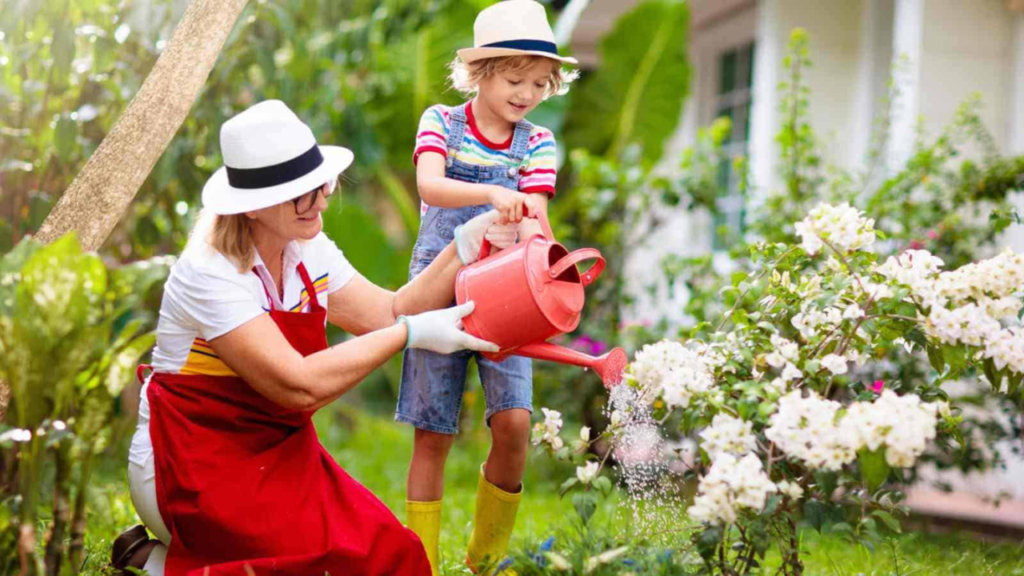Introduction
Bougainvillea is a lovely blossoming plant that is local to South America. It can add energetic varieties and excellence to any garden or home, yet it requires exceptional consideration to flourish. In this article, you’ll find out a lot about bougainvillea care, from where and how to establish it to perceiving normal vermin and sicknesses that can influence it.
Read More: 2024’s Hottest Trends in Wood Gate Design for Home
Bougainvillea, a vibrant and enchanting flowering plant, adds a burst of color to any garden. In this comprehensive guide, we delve into the art of caring for Bougainvillea: planting, cultivating, and tips for optimal growth. Whether you’re a seasoned gardener or a novice, these insights will elevate your bougainvillea cultivation game.
Bountiful Bougainvillea
Otherwise called paper blossoms, Bougainvillea is a dynamic, vivid plant that arrives in different shapes and sizes and has turned into a well-known decorative plant all over the planet. In spite of the fact that they seem to be petals, the blossoms of bougainvillea are really transformed into verdant designs called bracts.
See More: 25 Inside Garden Shed Ideas for Maximizing Your Outdoor Space
Assuming that you’re searching for something extraordinary and eye-catching for your nursery or home, then, at that point, bougainvillea could be exactly the thing you’re searching for! These dazzling blooming plants can provide a wealth of surface lasting through the year, particularly when established in holders or hanging bins that you can move around your outside space depending on the situation.
Bougainvillea Outline: The bougainvillea is a tropical and subtropical blossom frequently utilized for fancy purposes. An evergreen plant can grow up to 20 feet, moving vertical or outward. The blossoms come in gatherings of three, all trumpet-molded, drawing in pollinators. Colors incorporate purple, white, orange, red, and red. You can likewise find cross breeds where there are two different hued blossoms on a similar plant!
Tips for Outdoor Bougainvillea Care
Really focusing on bougainvilleas is certainly not a troublesome errand. To keep your plants in their best condition, it’s fundamental that they get sufficient water and sustenance with a reasonable manure two times yearly. Moreover, pruning during the late-winter or pre-winter supports new development and keeps up with the state of the plant.
You can fulfill your blossoms by adding natural mulch, for example, straw or wood chips, around the bougainvillea base to assist with holding soil dampness, decrease weed development, and add fundamental supplements over the long run. Besides, you ought to investigate your plants routinely for indications of bugs like aphids or mealybugs, treating them swiftly whenever found.
Read About: How to Build a Small Room Outside
Outdoor Bougainvillea Needs
With regards to establishing bougainvillea, the right area is fundamental. Bougainvilleas flourish in warm environments and splendid, backhanded daylight, so expect to establish them in a spot that gets no less than six hours of daylight everyday. You can establish them in compartments or straightforwardly into the ground; be that as it may, in the event that you decide to pot them, ensure you utilize a well-depleting preparing blend explicitly intended for bougainvillea plants. For outside planting, select a region with somewhat acidic soil and great waste.
Tip: The benefit of compartment planting is the capacity to move your plants inside when ice undermines them. They don’t do well in temperatures below 45 F.
Also Read: Grow Together in Your Family Garden
Bougainvillea: Trademark Plants in Singapore: Wherever you thoroughly search the Singapore scene, you’ll see this blossom. The weather conditions imply it blooms the entire year! Here, different names for bougainvillea incorporate Ye Zi Hua and Kembang kertas. Simply remember that cultivars of explicit plants regularly have other brand names. For instance, the Singapore White Bougainvillea is, in some cases, called Clifton Evening Glow.
Ideas for Garden Bougainvillea
This is a plant numerous grounds-keepers love since it’s flexible. You can utilize it to make garden walls, plant them close to pergolas, or use them in lattices. You will not experience difficulty finding a blossom you like!
Bougainvillea arborea: Lavender pink blossoms loaded up with aroma. Fifteen to thirty feet tall, this plant’s leaves obscure as the plant ages. Low support.
Bougainvillea buttiana: A rich, red bloom enhances this plant, having trumpet-formed little blooms in the middle. It’s a reduced tree, developing around 15 feet tall.
California Gold: Beautiful brilliant yellow bracts set against wavy-edged foliage. A quickly developing cultivar. Benefits from pruning.
Bougainvillea glabra: A dry spell open minded plant, a brilliant decision for holder planting. The red-pink blossoms seem cushy. Mature level between 10-12 feet.
Bougainvillea peruviana: Anticipate huge groups of vivid blossoms over time. This fiery climbing assortment (15 feet) is very teachable for developing on walls. The bark has a green tone. Prune this plant cautiously for the best outcomes.
Bougainvillea spectabilis is a typical cultivar that produces radiant purple blossoms in groups over time. The focal point of each untruth is a fragile white satin bloom. Heart-molded, shiny leaves encompass. This is a fantastic plant with a grown-up level of 15–40 feet.
Key West White: Detonates with white blossoms the entire season. Hummingbirds love this plant. 15-20 feet tall at development.
Goodness La: A maroon-blooming plant with a long season. As a smaller, diminutive person, you have a great deal of choices for this bougainvillea. They grow two feet tall and six feet wide.
Watering Techniques
Bougainvilleas need normal and predictable watering to flourish. Assuming you water excessively or too little, your plant could be in a tough situation. Overwatering can prompt root decay, a typical issue that can be hard to fix and may require supplanting the whole plant. Then again, underwatering can make the forgets about dry and become fragile, possibly prompting leaf drop.
Pitfalls in Bougainvillea Care
Thorny thistles: One of the fundamental downsides of bougainvillea is its sharp thistles, which can cause wounds. This makes it unacceptable for homes with youngsters, the elderly, or pets. Also, assuming you get pricked by one of the thistles, you might foster an unfavorably susceptible reaction like that of toxin ivy or toxic substance oak, prompting side effects like rankles, expanding, torment, tingling, and stinging. It’s fundamental for practice alert while taking care of bougainvillea.
Harmful sap: Bougainvillea’s sap is poisonous, and assuming ingested in adequate sums, it can make individuals and pets extremely sick. Take care to forestall ingestion and watch out for your pets around the plant.
Sprout necessities: Bougainvillea blossoms best when it’s water-pushed. This can represent a test for homes with programmed water system frameworks, as the plant may not get the ideal measure of water. You can resolve this issue by changing the water system framework to convey less dampness to the region where the plant is planted.
Obtrusive potential: Bougainvillea can possibly become intrusive in the event that it is not oversaw and kept up with appropriately. Its quickly developing nature and flexibility make it a gamble on the off chance that it spreads wildly. It’s critical to routinely prune and deal with the plant to keep it from becoming intrusive.
Dispersing necessities: Bougainvillea should be established at least four feet from walkways and comparable areas to forestall wounds to individuals and pets. To stay away from unsettling influence to other scene plants, it’s prescribed to develop bougainvillea somewhere around six to nine feet from some other plant. Appropriate dividing is fundamental for the wellbeing and soundness of different plants.
Common Pests & Plant Diseases
Identification and Prevention
Stay vigilant for common bougainvillea pests like aphids and caterpillars. Implement preventive measures, such as neem oil or insecticidal soap, to keep these nuisances at bay.
Organic Solutions
Embrace organic remedies like companion planting and introducing beneficial insects. These eco-friendly solutions protect your bougainvillea without harmful chemicals.
Aphids, caterpillars, nematodes, mealybugs, and other sucking irritations can all unfavorably influence the strength of your bougainvillea. Aphids are minuscule bugs found on the underside of leaves that feed off of the plant’s sap. They can cause leaf twisting, yellowing of leaves, hindered development, or withering of foliage. Caterpillars feed on the foliage of bougainvilleas, which causes staining and untimely leaf drop. Nematodes are tiny worms that feed on underground roots and ultimately decay the roots.
There are two diseases you can easily treat with fungicide.
Read More: 20 Best Garden Furniture Trends for 2023-24
Fine Mold: Fine buildup shows up as a white, fine covering on the leaves, stems, and blossoms of bougainvillea. It flourishes in muggy circumstances and can stunt plant development and lessen blossoming. To oversee fine buildup, further develop air courses around the plant, abstain from above watering, and apply fungicidal splashes if vital.
Leaf Spot Infections: Leaf spot illnesses manifest as dim or stained spots on the leaves of bougainvillea. These spots might have a yellow corona around them. To forestall leaf spots, try not to stand above water and eliminate impacted leaves quickly. Fungicidal medicines might be vital in extreme cases.
Choosing the Right Variety
Selecting the perfect bougainvillea variety is crucial for a thriving garden. Factors like climate, available space, and personal preferences should influence your choice. Explore the diverse options and find the one that suits your unique gardening needs.
Planting Bougainvillea
Ideal Soil Conditions
Bougainvillea thrives in well-draining soil. Incorporate organic matter and ensure proper drainage to prevent waterlogged roots. A slightly acidic to neutral pH range is optimal for these plants.
Watch for signs of stress. Yellowing leaves may indicate overwatering, while drooping or wilting can signal underwatering. Strike a balance to maintain optimal soil moisture.
Fertilizing Strategies
Best Fertilizers for Bougainvillea
Choose a balanced fertilizer with a higher potassium content to promote flowering. Apply during the growing season, following package instructions.
Application Timing
Fertilize bougainvillea every 4-6 weeks during the growing season. A slow-release fertilizer can provide a steady nutrient supply for sustained growth.
Pruning Techniques
Importance of Pruning
Pruning is vital for shaping and controlling bougainvillea growth. Remove dead or diseased branches to encourage new growth and maintain a tidy appearance.
Step-by-Step Guide
Prune after the blooming period, cutting back up to one-third of the plant. Trim long, unruly branches and shape the plant to your desired form.
Conclusion
These are only a couple of captivating realities about Bougainvillea. Whether you value its dazzling visual showcase or its capacity to flourish in testing conditions, Bougainvillea is a charming plant that adds dynamic quality to nurseries and scenes all over the planet. Presently it’s spotting your scene, painting the yard with colors.
In mastering the art of Caring for Bougainvillea – Planting, Cultivation, and Tips for Optimal Growth, you unlock the key to a flourishing garden adorned with vibrant hues. By combining expert insights with personal care, your bougainvillea will thrive, becoming a testament to your green thumb.
Final Thoughts on Bougainvillea Care
Despite the fact that you can utilize bougainvillea in an upward direction, I’m miserable. My yard essentially can’t uphold that measured bramble/tree. I urge you to take a gander at your space with a basic eye prior to settling on this plant or while getting one that suits the room you have in your scene.
FAQs about Bougainvillea
Are bougainvilleas suitable for indoor cultivation?
Yes, but they require abundant sunlight. Place them near a sunny window or provide supplementary light.
How often should I fertilize my bougainvillea?
Fertilize every 4-6 weeks during the growing season with a balanced, potassium-rich fertilizer.
Can I grow bougainvillea from cuttings?
Absolutely! Use mature, healthy cuttings and follow proper propagation techniques for success.
What is the best method to control pests on bougainvillea?
Implementing natural predators like ladybugs and maintaining a clean garden reduces pest infestations.
Do bougainvilleas need winter protection?
In colder climates, provide shelter or bring potted bougainvillea indoors to protect them from frost.
How do I encourage blooming in my bougainvillea?
Ensure proper sunlight, well-draining soil, and follow a consistent pruning and fertilizing schedule for abundant blooms.

